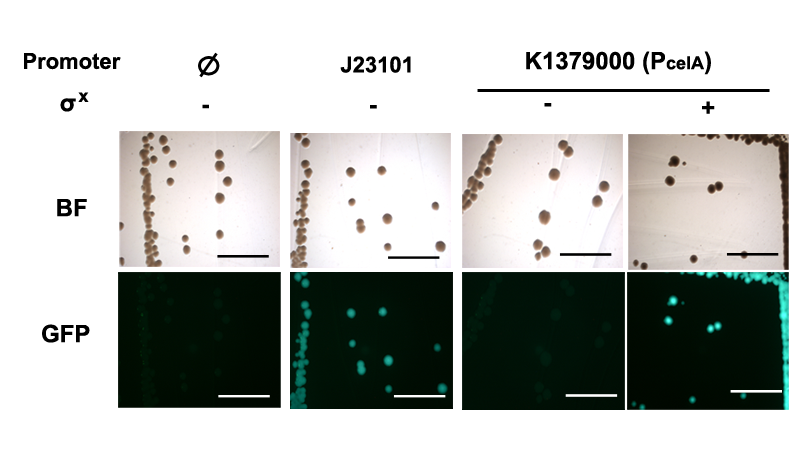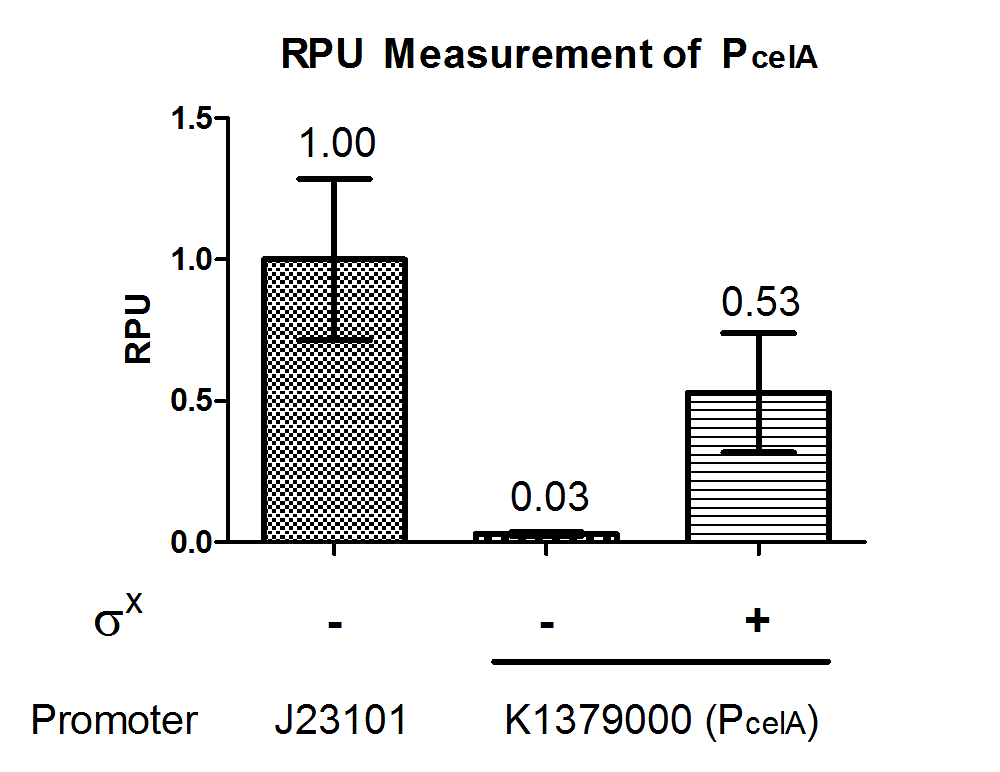Part:BBa_K1379000
PcelA
Usage and Biology
PcelA (also known as celAp) is a promoter in Streptococcus pneumoniae under the regulation of sigma factor σX.
A sigmaX-inducible promoter initiating the transcription of competence CelA protein in Streptococcus pneumoniae NCTC7465 strain. PcelA (chbBp) is a promoter which proves to be functional in E. coli and S. pneumonia. This promoter works when induced by SigmaX protein BBa_K1379004. The sigmaX protein will bind to 8 base pairs of PcelA (chbBp) promoter and trigger gene expression. The sigmaX gene and PcelA (chbBp) promoter used in the construct are both cloned from E. coli NCTC 7465 strain. R.P.U (Relative Promoter Unit) of PcelA (chbBp) is measured to represent promoter strength in reference to constitutive promoter BBa_J23100. PcelA (chbBp) promoter is characterized in E. coli DH10B cell as it is frequently used by iGEM participants.
Characterization
Method
By linking PcelA promoter with GFP generator (BBa_E0240), and SigmaX generator(BBa_K1379006), the promoter activity was represented by the GFP synthesis rate. Fluorescence was measured when the cells are in the mid-log phase. OD595 values were measured and converted to OD600 to obtain the R.P.U of the promoter.
To measure the RPU (Relative Promoter Unit) of PcelA promoter, we adopted the method described by Kelly et al. in “Measuring the activity of BioBrick promoters using an in vivo reference standard” (Kelly et al., 2009). With the use of EnVision multilabel reader from Perkin Elmer Company, it enabled us to obtain the fluorescence and absorbance of cells over time. GFP intensity and OD595 values were measured every 30 minutes after the E. coli strains are cultured to mid-log phase.
The positive control used in this characterization is BBa_I20260 which is a constitutive promoter BBa_J23100 containing GFP generator BBa_E0240, while the negative control used in this characterization is BBa_K1379002 which is PcelA promoter with GFP generator but without SigmaX generator.
The detailed description including characterization procedure and Data processing of our characterization can be found in [http://2014.igem.org/Team:Hong_Kong_HKUST/pneumosensor/characterization iGEM HKUST 2014 Wiki Page].


Discussion
PcelA promoter is working in E. coli DH10B strain, and express GFP when induced with SigmaX protein. In comparison to the reference promoter BBa_J23101, the R.P.U (Relative Promoter Unit) of PcelA promoter is around 0.5. From Figure 2, we could tell that this promoter is specific as there is almost no GFP expression in the absence of SigmaX protein inducer. This might indicate that the 8 basepairs combox region in PcelA promoter is specific to SigmaX. However, further characterization needs to be done to evaluate crosstalks between this inducer-promoter system.
Sequence and Features
- 10COMPATIBLE WITH RFC[10]
- 12COMPATIBLE WITH RFC[12]
- 21COMPATIBLE WITH RFC[21]
- 23COMPATIBLE WITH RFC[23]
- 25COMPATIBLE WITH RFC[25]
- 1000COMPATIBLE WITH RFC[1000]
Reference
J. R. Kelly, A. J. Rubin, J. H. Davis, J. Cumbers, M. J. Czar, ..., D. Endy. (2009). Measuring the activity of BioBrick promoters using an in vivo reference standard. Journal of Biological Engineering, 3, 4. doi: 10.1186/1754-1611-3-4
//classic/regulatory/uncategorized
| None |
